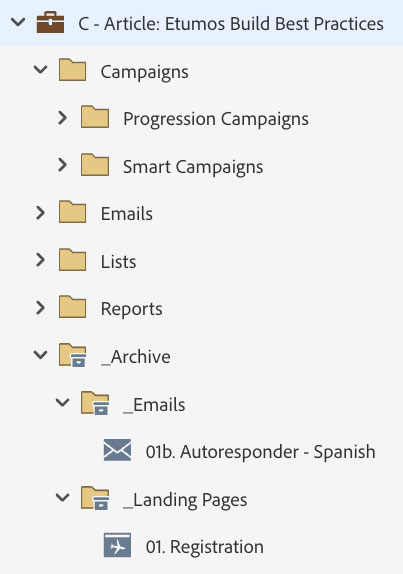Overview
We may all have the same 24-hour day, but most people don’t go spending it all on building one marketing campaign. So what can you do to make sure that your time is spent wisely? Start identifying your marketing campaign build times and develop strategies to optimize your campaign build process.
What are campaign build times?
Campaign build times measure the amount of time that it takes for someone to set up a marketing campaign, like a webinar, an email send, or a direct mail campaign. That build time starts when all intake needs have been met and assigned to a person to execute, and ends when the campaign is ready for QA and launch. How is this time different from a Service Level Agreement (SLA)? This time can be measured like a stopwatch, rather than a running clock. So while an SLA may guarantee that the build will be completed in 2 days, the actual build time may only take 45 minutes. SLAs may need to include more time to account for the realities of your workplace: cross-department collaboration, time zone differences, or allowing the campaign production team to deliver multiple requests on the same timeline.
Why should companies carefully monitor campaign build times?
Slow campaign build times can be an indicator of inefficiencies. If your organization is planning to scale up production or needs to account for seasonal or timely requests, it’s vital to improve build time so those inefficiencies do not multiply. You can dive deeper into why campaign builds are taking longer than expected to uncover unclear requests, miscommunication, changing content or priorities, and the list goes on. Time is money, so reducing time reduces your overall spend, offering better campaign ROI.
When should companies re-evaluate their existing process based on their build times?
It may take a while to establish a baseline to understand average build time, so if you are just beginning to standardize your campaign production process, an important thing to do would be to document how long a build takes, and even break out those times by campaign type. Once you have data to inform your decision-making, you can set benchmarks and plan how to speed things up. If your team can demonstrate an efficient process, then you may be able to justify adding additional resources or budget.
How can companies implement efficiencies that reduce build times?
 There are several ways that companies can work to reduce build times. First, make sure that all efforts have been made to establish a robust intake process for campaign requests. This will ensure that build time is not wasted on requirements gathering, hunting down email copy or creative assets, or working through rounds of edits with the campaign requester.
There are several ways that companies can work to reduce build times. First, make sure that all efforts have been made to establish a robust intake process for campaign requests. This will ensure that build time is not wasted on requirements gathering, hunting down email copy or creative assets, or working through rounds of edits with the campaign requester.
Next, look at the tools you use to complete campaign builds. In a marketing automation platform like Marketo Engage, create cloneable program templates for campaign consistency. It can also be helpful to have pre-made email designs so you’re not applying extra time to designing emails from scratch. Keep up to date with marketing and sales processes to make sure that your templates stay in alignment. Maintain organizational structure with consistent naming conventions and archive any unused assets as you go.
Before you send a campaign back to the requester for review, do a thorough self-QA. Send email samples to yourself, fill out your landing page form, and check your test lead’s activity. Understand the campaign’s goals and make sure that the campaign’s setup will achieve them. If you see anything that does not align to best practices, be ready to suggest a best practice approach that can be used instead.
Finally, have an established build SLA and discuss the review processes with your marketing team. Make sure that when someone requests a marketing campaign, they understand their role in reviewing content and the timeframe in which it needs to be completed. Suggest that they compile feedback rather than engage in rounds of changes. If changes start to become overwhelming and alter the scope of the build, pause work and have a conversation about what’s needed.
Who should be involved in evaluating, monitoring, and improving build times?
Your marketing operations team will work closely with marketing managers to architect a campaign production process that prioritizes both timeliness and quality. A dedicated project manager can help to set up ways to monitor build times through PM tools, and campaign builders can help identify patterns or inefficiencies to improve over time.
Conclusion
It’s important to remember that build times will never reach 0. So at some point, your team is going to reach peak performance, but the path to getting there isn’t always linear. New hires may need to be trained on campaign production best practices. Focus on maintaining open communication with the marketing team. Make adjustments to your process as inefficiencies are identified. Work toward perfection with incremental improvements, and soon you will develop a team culture that seeks out ways to improve and optimize processes.







